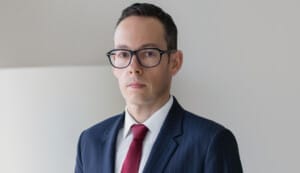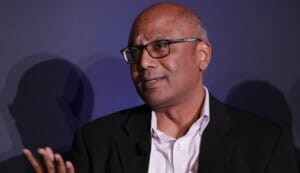Artificial intelligence is, at its core, a technology for making predictions. The trick to making it work productively is to frame the things it is asked to do as prediction problems: given what has already happened, what is the next most likely thing to happen, and how do we prepare for that?
That’s why it potentially lends itself well to an investment setting. Investing, at its core, is also about making predictions – and the faster and the more accurate the better.
The specific roles AI is best cut-out to play inside an investment business depend heavily on how particular businesses work. Quantitative investors, for example, may make greater use of AI sooner than traditional, fundamental stock-pickers.
Co-head of Quest, quantitative business strategy at Pictet Asset Management (Pictet AM), David Wright, says that if artificial intelligence were a human being, then at its current stage of development and capabilities it would probably be hired into his quant team at a graduate level, producing research and identifying trading signals for review and implementation by human portfolio managers.
“That is a pretty good question,” Wright says.
“It depends on the type of AI being utilised. Let me give you two examples here.

“My own team, the quant team, have been playing around with the recent ChatGPT rollout. I want to make it very clear, this is not something we’re using, we’re not using large language models, it was just one or two of them playing around with it,” he says
“My head of investments basically set it a number of tasks that we would have given to a graduate quant, and he said this recent iteration was good enough to answer the questions in a way that they’d have passed the bar on that stage of the testing to bring them in as a grad in the team.”
Wright says Pictet AM has built a quant stock selection that understands better which data sources are more relevant for making productions. In this scenario, one could equate the use of AI not to replacing a portfolio manager per se, because a portfolio manager is still there but involved in a different element of the process, but “you could say that the tool is being used for something that they would have historically done”.
Clear use cases
Technology moves quickly. As new applications for AI’s predictive powers are conceived and as access to compute becomes cheaper, asset owners are constantly investigating new ways to use it. But they’re also proceeding deliberately and setting out clear use cases before taking the plunge.
OPTrust director of total fund completion portfolio strategies Jacky Chen says the implementation of AI in OPTrust’s $24 billion investment operations continues to steadily develop its AI capacities, and he’s confident it’s on the right track.
“We view AI implementation as an ongoing journey rather than a one-time project,” Chen says.
“During this period, we have continued to explore and deploy high-value use cases within the organisation and provide user training.”
Around 12 months ago, Chen told top1000funds.com that AI was initially used within OPTrust’s investment operations to manage risk, playing to its strengths of being able to analyse very large volumes of data very rapidly. A year ago it was utilising machine learning and data science in its public market strategies.
“We are now leveraging generative AI for tasks such as synthesising large amounts of information and providing coding assistance,” Chen says.
“These initiatives require time to develop, and we are continually learning and improving our processes.”
Other asset owners take a similarly measured approach. A spokesperson for the $500 billion California Public Employees’ Retirement System (CalPERS) says the fund uses “some generative AI and machine learning tools, largely through our standard investment business subscriptions, and to inform and augment decision-making”.
“That said, these tools do not replace human judgement,” the spokesperson says.
“Also, this is an area of ongoing change, and we continue to explore and monitor its usefulness for our business and its impact on the portfolio companies we own.”
Decision trees
Pictet AM’s Wright says the asset manager uses AI in a quant setting to generate return forecasts, “and then we use that within an optimisation to build a portfolio.”
“Historically, you would have generated the forecast by testing a number of signals and then combining them together with weights that were defined by the portfolio manager,” he says.
“The model that we’ve just described there had to be trained on those signals in the data historically, so it understands the relationships between them.
“But within the framework of that machine learning, there were hundreds, if not thousands, of individual decisions that had to be made, from a macro level about what type of machine learning that you use, to a micro level – and we’re going to get a bit more technical here – like once you’re using a decision tree-type process, how many layers of the tree – different branches – do you allow? How many runs do you do of it? All these different parameters. These are all chosen by the person developing the system.”
Teacher Retirement System of Texas senior managing director of multi-asset strategies group Mohan Balachandran told the top1000funds.com Fiduciary Investors Symposium at Stanford University in September that the greatest use of AI for the $200 billion organisation is in creating decision trees.

“That’s exactly what we use to pick signals in the equity portfolios,” he said.
“It used to take a long time to update your models, because people would do univariate regressions, and things like that. But once we started using [AI], it’s just become a very quick and fast turnaround, so much so that now instead of like global models, we’re more focused on sector models and country models.”
Balachandran said the efficiency the asset owner has achieved “has been tremendous”.
“And plus, all these things are open source, so the cost and the barriers to entry has been greatly reduced for us,” he said.
“The cost is now really on the data side, so that’s where we’ve been focused on.”
Pictet AM’s Wright says the trick to training an AI is to strike a balance between having enough data and keeping it relevant to the task.
“It’s still better if they’re really large [datasets], but really large and focused is better than absolutely massive and unfocused,” Wright says.
“You still need a minimum kind of level. Say you’re building something that it’s going to do financial natural language processing. You want to train it on every earnings call transcript that you can find, you want to train it on every 10k filing that you can find, you probably want to train it on news flow; but you don’t need to train it on Wikipedia, for example.”
Not yet replacing people
In some settings, AI is assuming roles and carrying out tasks previously done by people. But even then, there is human review of the outputs – a sanity-check, of sorts.
Wright says that in the specialised environment that he manages, AI is making stock selection decisions.
“That is essentially what’s happening,” Wright says.
“A quant investment process, you kind of think of it as three steps. There is bringing in the data; cleaning the data; and then turning that data into signals that are going to tell you something about stocks in the cross section.
“And then at the end, there is something that I mentioned earlier, like an optimisation of a big algorithm that essentially takes return forecasts, cost, risk estimates, lots of constraints and has an optimisation function to build a set of portfolio holdings.”
In between, Wright says, is a stock forecasting model that might incorporate as many as 50 weighted signals to come up with a decision.
“The output of that is a model that you then feed into the optimisation and you trade on it,” he says.
“In the machine learn world you’re just creating those return forecasts in the middle in a more sophisticated way; but in quant in general, to go back to your original question, you trade the output of a model. It is a model creating the return forecast, and then once you put that into an optimisation, the optimiser is choosing the positions to take in the portfolio.”
Chen says OPTrust does not regard AI as directly comparable to a human employee, “because there are many aspects of a job that require human judgment, creativity, and interpersonal skills”.
“While Generative AI is becoming proficient at specific tasks such as writing and coding, it is not capable of performing an entire job that a human can,” Chen says.

“Instead, we see AI as a technology that assists humans by streamlining certain portions of their work. For example, AI can handle data analysis, automate routine tasks, and provide coding assistance, allowing our team members to focus on higher-value activities that require human insight and decision-making.
“Therefore, rather than thinking of AI as a graduate-level ‘employee’, we consider it a powerful technology that enhances our team’s capabilities and efficiency.
“While AI is promising, we adhere to the principle that humans are ultimately accountable for the work product. We ensure that humans remain in the loop, with AI serving as a co-pilot to our people. This approach helps us maintain a balance between leveraging AI’s capabilities and ensuring responsible oversight.”
Staying in control
A characteristic of machine learning is that the way it arrives at decisions or outputs changes over time as it “learns” or assimilates new data. It could pose an issue if an asset owner is not constantly on top of what its AI is doing, and how it’s doing it.
HESTA head of portfolio design Dianne Sandoval told the Stanford FIS event the A$90 billion ($60 billion) asset owner runs a quantitative strategy team, along with some economists that use quantitative models and AI models to determine fair value across asset classes.
 “And then the way that we implement it, I think, is a bit unique, because we take a very total portfolio approach,” she said.
“And then the way that we implement it, I think, is a bit unique, because we take a very total portfolio approach,” she said.
HESTA’s Sandoval said it’s vital that asset owners understand what their AIs are doing and how they do it in the interests of transparency in reporting to members and beneficiaries, meeting regulatory requirements and complying with audits.
“The thing that’s really important for us, we’re a highly regulated industry,” Sandoval told FIS.
“In Australia the super industry is highly regulated, and it’s a competitive industry, because our members can get up and leave. So, we have to be really careful about ensuring that we have KPIs and audits.
“It’s really important that we can be really clear as to what the model is telling us, why the model is behaving the way it’s behaving, and that if we get audited or the regulator comes in, we can explain the behaviour of that model [and] that it’s not a black box.”
AI is also proving useful in cases where asset owners outsource investment management – in whole or in part – to third-party asset managers. CPP Investments managing director and head of strategy execution and relationship management Judy Wade told the FIS event at Stanford that there’s a vast amount of knowledge and insight “in our $650 billion in assets and 1000 investors’ heads and our partners’ [heads]”.
“That knowledge is really a key strategic competitive advantage for us,” Wade said.
She said the role of AI currently is to “accelerate our investors’ ability to make investment decisions”, and that the aim is not to replace investors or partners.

CPP fundamentally believes that “it is our data combined with large language models that provides us with proprietary insights, and that is, again, our data [and] our partners’ data”, Wade said.
She said that because the AI system has full information source-attribution at its core, it is a “near zero-hallucination environment”.
“Things aren’t being made up, which is really, really critical for our investors.”
Pictet AM’s Wright says that “when an asset owner uses outside managers, and again, I’m thinking specifically for some of their equity allocations here, they want to have a return that is beating the benchmark, delivering them some active return”.
“Say that a traditional quant model, on average, is able to outperform the index for them by 1 per cent, and maybe this next-generation approach is able to outperform by one and a half to 2 per cent for them, that additional unit of return, compounded over 20 or 30 years, can be quite significant,” he says.
Saving time, solving problems
Also at FIS, Matthew Shellenberger, senior manager of asset allocation and risk management at the WK Kellogg Foundation, said AI helps smaller asset owners such as the foundation – with 11 individuals in its investment team – to free-up time to focus on higher value-adding activities.
“There’s a time savings component,” Shellenberger said.
“There’s a faster processing component. And I would also say that for us, it’s also around idea elevation, which I think is for a group like ours, with a smaller team [means] being able to digest materials from [more than] 100 relationships, and actually be able to cultivate our own portfolio and our own tilts.
“The time savings one is readily noticeable for anyone who’s used any of these tools in any sort of administrative capacity. I think that also frees up your time to be more innovative in other areas of your portfolio and actually focus on the work that really does drive either active risk, and hopefully active return.”
OPTrust’s Chen says that 12 months further down the track of working with AI, the deployment has lived up to expectations.
“We have been integrating machine learning and data science into our strategies for the past six years, and over the past 18 months, we have been exploring Generative AI,” he says.
Chen says that 12 months ago “most AI applications focused on solving single-step problems, such as coding for specific calculations”.
“These applications were not good at handling tasks requiring multi-step problem-solving,” he says.
“Since then, we have seen advancements in AI’s ability to tackle more complex, multi-step problems, often referred to as agentic AI. This type of AI can assist portfolio managers in completing more intricate tasks, such as comprehensive data analysis.”
Published in partnership with Pictet Asset Management